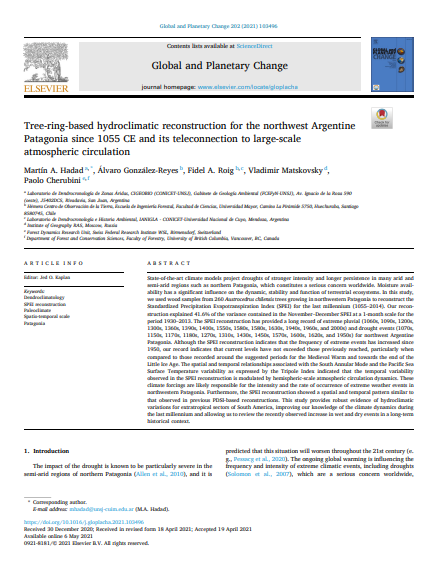Tree-ring-based hydroclimatic reconstruction for the northwest Argentine Patagonia since 1055 CE and its teleconnection to large-scale atmospheric circulation

Fecha
2021-07Autor
Hadad, Martin A.
González-Reyes, Alvaro [Univ Mayor, Hemera Ctr Observac Tierra, Escuela Ing Forestal, Fac Ciencias, Chile]
Roig, Fidel A. [Univ Mayor, Hemera Ctr Observac Tierra, Escuela Ingn Forestal, Fac Ciencias, Chile]
Matskovsky, Vladimir
Cherubini, Paolo
Ubicación geográfica
Notas
HERRAMIENTAS
Acceda a títulos restringidos
¿Cómo descargar?Resumen
State-of-the-art climate models project droughts of stronger intensity and longer persistence in many arid and semi-arid regions such as northern Patagonia, which constitutes a serious concern worldwide. Moisture availability has a significant influence on the dynamic, stability and function of terrestrial ecosystems. In this study, we used wood samples from 260 Austrocedrus chilensis trees growing in northwestern Patagonia to reconstruct the Standardized Precipitation Evapotranspiration Index (SPEI) for the last millennium (1055-2014). Our reconstruction explained 41.6% of the variance contained in the November-December SPEI at a 1-month scale for the period 1930-2013. The SPEI reconstruction has provided a long record of extreme pluvial (1060s, 1090s, 1200s, 1300s, 1360s, 1390s, 1400s, 1550s, 1580s, 1580s, 1630s, 1940s, 1960s, and 2000s) and drought events (1070s, 1150s, 1170s, 1180s, 1270s, 1310s, 1430s, 1450s, 1570s, 1600s, 1620s, and 1950s) for northwest Argentine Patagonia. Although the SPEI reconstruction indicates that the frequency of extreme events has increased since 1950, our record indicates that current levels have not exceeded those previously reached, particularly when compared to those recorded around the suggested periods for the Medieval Warm and towards the end of the Little Ice Age. The spatial and temporal relationships associated with the South Annular Mode and the Pacific Sea Surface Temperature variability as expressed by the Tripole Index indicated that the temporal variability observed in the SPEI reconstruction is modulated by hemispheric-scale atmospheric circulation dynamics. These climate forcings are likely responsible for the intensity and the rate of occurrence of extreme weather events in northwestern Patagonia. Furthermore, the SPEI reconstruction showed a spatial and temporal pattern similar to that observed in previous PDSI-based reconstructions. This study provides robust evidence of hydroclimatic variations for extratropical sectors of South America, improving our knowledge of the climate dynamics during the last millennium and allowing us to review the recently observed increase in wet and dry events in a long-term historical context.
URI
https://repositorio.umayor.cl/xmlui/handle/sibum/9163https://doi.org/10.1016/j.gloplacha.2021.103496
https://doi-org.bibliotecadigital.umayor.cl:2443/10.1016/j.gloplacha.2021.103496
https://www.dora.lib4ri.ch/wsl/islandora/object/wsl%3A26966/datastream/PDF2/Hadad-2021-Tree-ring-based_hydroclimatic_reconstruction_for_the-%28accepted_version%29.pdf
Coleccion/es a la/s que pertenece:
Si usted es autor(a) de este documento y NO desea que su publicación tenga acceso público en este repositorio, por favor complete el formulario aquí.